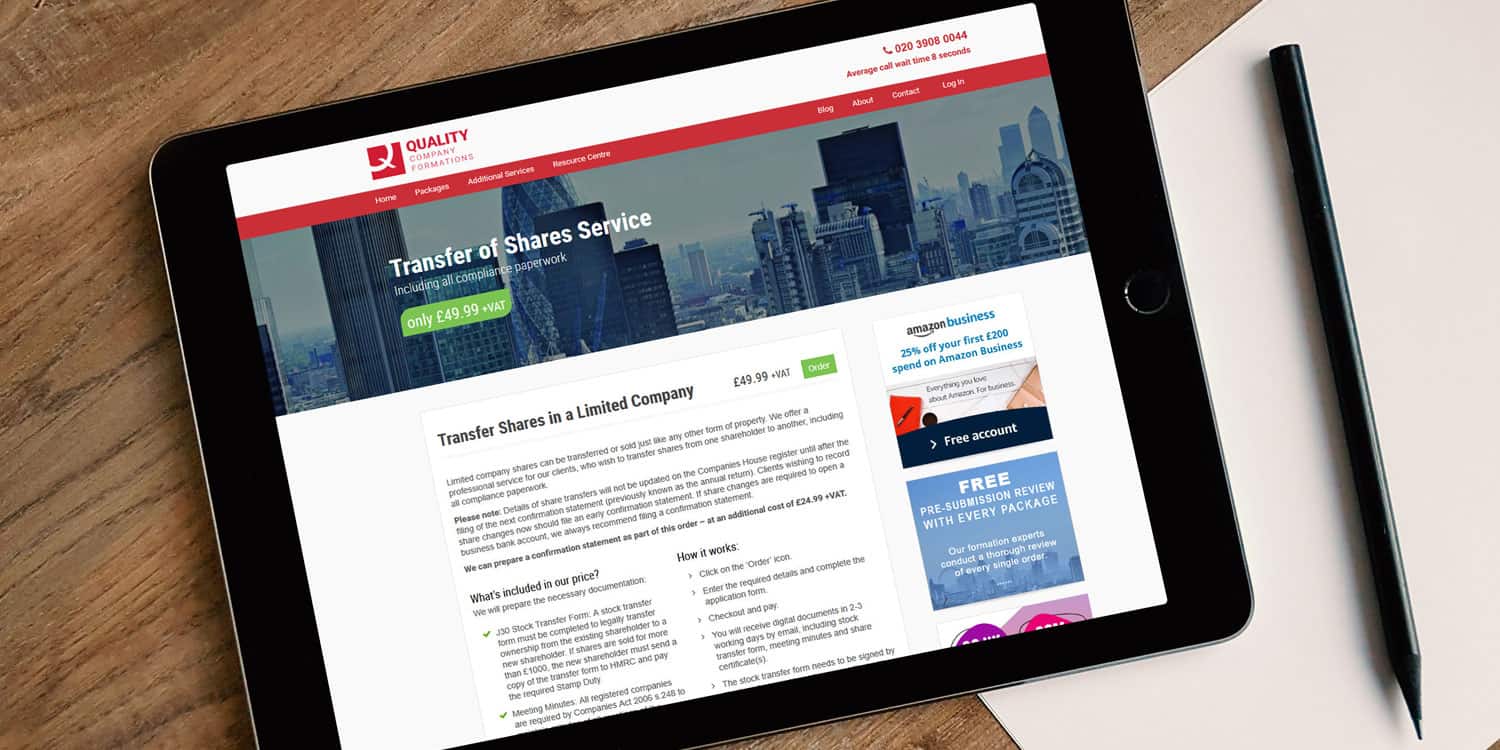The transfer of company shares process is when a limited company shareholder sells or gifts their shares to someone else. The recipient of these shares may be a new or existing shareholder. It is a very common procedure that arises for a variety of reasons, such as:
- The company needs to raise additional investment
- A new business partner is brought on board
- A shareholder wishes to leave the company and recoup his or her investment
- The death of a shareholder
- A director who is also a shareholder resigns, retires or is removed from the company
- Transferring shares to a tax-efficient ISA or pension fund
- Gifting shares to a spouse or other family member as a tax-efficient strategy
- The company owner is retiring and wishes to hand the business over to his or her children or sell it to someone else.
Key takeaways
- Complete a Stock Transfer Form to efficiently transfer shares, ensuring compliance with your company’s articles of association.
- Pay Stamp Duty at 0.5% if the share consideration exceeds £1,000 to avoid delays in documentation.
- Implement pre-emption rights in your articles to protect existing shareholders from unwanted ownership changes.
In many situations, it is straightforward to transfer your company shares to someone else. You simply need to complete a Stock Transfer Form and then present it to the board for consideration. However, if there is more than one shareholder in your company, you should check the terms of the articles of association and any shareholders’ agreement you may have. These documents sometimes contain restrictions on the transfer of shares.
Completing a Stock Transfer Form
A Stock Transfer Form is the standard document that must be completed to transfer company shares in a UK limited company. For fully paid shares (i.e., when the current shareholder has paid the nominal value of his or her shares to the company), a J30 Stock Transfer Form should be used. For unpaid or partly paid shares, you will need to use form J10.
If no particular restrictions are present in the articles of association or shareholders’ agreement, you can go ahead and complete a J30 Stock Transfer Form with the following details:
- Consideration money – Amount of cash, if any, being paid for the shares. Enter ‘NIL’ if no cash is being paid
- Full name of undertaking – Name of the company in which the shares are held
- Full description of security -Class/type of share and nominal value, e.g., Ordinary shares of £1
- Quantity of shares being transferred
- Name, address, and signature of current shareholder
- Name and address of the recipient of the share(s)
- Completion of Certificate 1 or 2 on the form if no Stamp Duty is due to be paid to HMRC
Certificate 1
You should complete certificate 1 if both of the following apply:
- Consideration for the shares is £1,000 or less
- The transfer does not form part of a larger transaction or series of transactions where the total exceeds £1,000
You do not have to tell HMRC about the transfer, but you must send the stock transfer form and the share certificate to Companies House. They will then issue an additional share certificate to you.
Certificate 2
You should complete certificate 2 in the following situations:
- The transfer is exempt from Stamp Duty, for example, if the transfer is in connection with a divorce or the dissolution of a civil partnership
- The consideration given is not a chargeable consideration
No certificate required
There is no need to complete either certificate if there is no consideration (i.e., NIL) given for the shares or if you’re claiming relief from Stamp Duty. If you are claiming a relief, you will need to send the completed stock transfer form and details of the relief you are claiming to HMRC for stamping.
Detailed guidance on Stamp Duty reliefs and exemptions, including how to apply, is available from HMRC.
When Stamp Duty needs to be paid
If the new shareholder is paying more than £1,000 for the shares, the Stock Transfer Form must be stamped by HMRC. The new shareholder must pay 0.5% Stamp Duty on the total amount he or she pays for the shares.
Calculating Stamp Duty payment
The amount of Stamp Duty to be paid is based on the ‘chargeable consideration’ given for the shares. The new shareholder must pay Stamp Duty at the rate of 0.5% of the value of the chargeable consideration, rounded up to the nearest £5. For example:
- Consideration paid for shares is £1,800
- Stamp Duty is 0.5% of £1,800
- £1,800 × 0.5% = £9.
- This is rounded up to the nearest £5, which means the new shareholder pays £10 Stamp Duty to HMRC.
Getting your stock transfer form stamped
The completed Stock Transfer Form should be sent to HMRC for stamping within 30 days of the ‘effective date’ of the transfer. This is normally the date on which the form is signed.
You should also include a self-addressed envelope and any agreement and supporting documents if HMRC has given a formal opinion or adjudication on how much Stamp Duty should be paid.
The Stamp Duty must be paid before HMRC will send you the stamped documents. Any delayed payment may hold up the documents being sent to you.
All being well, HMRC will deal with your Stock Transfer Form within 5 working days of receiving it. You should also allow approximately 10 days for the form to be returned to you by post. When you receive your stamped form back from HMRC, you will need to send it to Companies House, along with the share certificate.
Recording share transfers
When the Stock Transfer Form has been completed and (where applicable) returned from HMRC after stamping and Stamp Duty payment, the company director should issue a share certificate to the new shareholder and record the transfer in the Register of Members (shareholders), which is normally kept at the company’s registered office address.
To update the register, you must:
- Update the number of shares held by the transferor (shareholder who sold/gifted the shares) and the date on which this changed
- Enter the name, address, and shareholdings of the recipient of the shares. For existing shareholders, you simply need to update their shareholdings against their name/address entry on the register
The company must retain a copy of all Stock Transfer Forms, share certificates, and any resolutions relating to the transfer of shares.
If the transfer of shares impacts the People with Significant Control (PSC) in the company, you must update your PSC register within 14 days of the transfer going through. You must also update Companies House of the change in PSC within 28 days of the transfer.
Informing Companies House of share transfer
Companies House should also be notified of any changes to shareholders or shares on the next Confirmation Statement.
You can wait until it’s time to file your Confirmation Statement. Alternatively, you can update this information early if you want the transfer recorded on the official register immediately.
It is usually recommended to file a Confirmation Statement immediately if you are opening a bank account or contracting with any third party.
You should also tell Companies House of any changes to the PSC within 28 days of the transfer taking place. To do so, you must use Companies House forms PSC01-09.
Restrictions on the transfer of shares
The transferability of shares is an important feature of a private limited company because it facilitates flexibility of ownership and capital investment opportunities for small to medium businesses, many of which are family-owned and operated.
This philosophy is expressed well in Palmer’s Company Law, which states:
“It is well settled that unless the articles provide otherwise the shareholder has a free right to transfer to whom he will. It is not necessary to seek in the articles for a power to transfer, for the Act itself gives such a power. It’s only necessary to look to the articles to ascertain the restrictions, if any, upon it. Thus, a member has a right to transfer his shares to another person unless this right is clearly taken away by the articles”.
It is the right of existing shareholders in a private limited company to add certain restrictions on the transfer of shares to ensure the company is managed appropriately and to secure their best interests at all times. For this reason, you can add tailored restrictions to your articles of association and shareholders agreement, including:
- right of pre-emption in favour of existing shareholders
- board of directors’ power to authorise the transfer of shares
- buy-back options of the company
Right of Pre-emption
The right of pre-emption is the most common type of share transfer restriction included in the articles of association. This clause provides that existing members are given first refusal to purchase the available shares before they can be offered to anyone outside of the company.
The purpose of pre-emption rights is to ensure that the control of shares does not fall into the hands of any unsuitable or undesirable persons who may not have the company’s best interests at heart or to protect the existing holdings of current shareholders.
Normally, the available shares are offered to existing members on a pro-rata basis (i.e., in relation to their current percentage of shareholdings).
There are various types of pre-emption clauses that you can include in your company’s articles, such as:
- The transferor may first offer his or her shares to all other shareholders
- The transferor may select the shareholder that he or she wishes to sell the shares
- First refusal to purchase the available shares is offered to certain enumerated shareholders (e.g., those holding founding members’ shares)
- Under certain circumstances, such as the death of a shareholder, the remaining members or directors are required to take the shares of the deceased member
Director’s power to authorise share transfers
In many private limited companies, the board of directors has the default power to refuse a share transfer. However, this may not be ideal for some companies because it can have serious limitations for the owners (shareholders) of the business.
The most common setup is to include a clause in the articles of association and shareholders’ agreement stating that no transfer of shares can be approved without the consent of all members or a majority of members.
When a shareholder wishes to sell some or all of his/her shares, the other members will be required to pass a resolution at a general meeting to approve the transfer, in accordance with the provisions in the articles and shareholders’ agreement. Alternatively, shareholders can often simply write to the company individually to waive their right to pre-emption.
Buy-back options
It is common for companies to include buy-back options in their articles, which dictate that any directors or employees who hold shares must transfer their shares back to the company when they leave. This is to ensure that only those directly involved in the business can be shareholders and that the company always retains control of who may be issued with shares.
Buy-backs, on the whole, are a more complicated affair than simple transfers, and companies seeking to undertake this should seek legal advice beforehand.
Our Share Transfer Service
If you need assistance with the transfer of shares, Quality Company Formations provide a comprehensive Share Transfer Service at a cost of only £129.99 plus VAT.
We will prepare the necessary documentation: J30 Stock Transfer Form, meeting minutes confirming that the directors have approved the share transfer, and share certificate(s).














Join The Discussion
Comments (2)
Hello,
We have a Limited Company set up. It is non trading dormant company. The main Shareholder holds 99 shares and we need these shares to be transferred into 33 to our one son, 33 into our second son and 33 to myself. 1 share I already have. We are all in agreement that no money needs to change hands. We need a cost for this and can you do it. We also need ongoing a registered address and annual accounts prepared to Companies House as non trading.
Our sons live in Gibralter and myself and my wife live in Spain.
We would be grateful to hear from you. Thanks.
Hi Richard,
Thank you for your recent enquiry. We would of course be happy to assist with these matters.
Our fee for assisting with the three share transfers will be £69.99 plus VAT and will include the necessary statutory documents – board meeting minutes, stock transfer forms and share certificates).
Should you require the change in shareholding to be updated on Companies House public register, we can also assist with filing the confirmation statement subsequent to the transfer of shares. We do provide a discounted fee of £24.99 plus VAT for our assistance with the filing of the confirmation statement, if it is purchased at the same time as the transfer of shares.
We would be happy to assist with filing your dormant company accounts for the company on Companies House public register, for a fee of £39.99 plus VAT.
With regards to our Registered Office address service, we provide our prestigious Covent Garden address as a registered office address for a fee of £39.00 plus VAT, and as the service address for any directors for £26.00 plus VAT per directory.
Should you wish to purchase any of these services, please visit our website, or call our Company Secretarial Team on 020 3984 5389 and we would be happy to assist you.
Kind regards,
James Howell